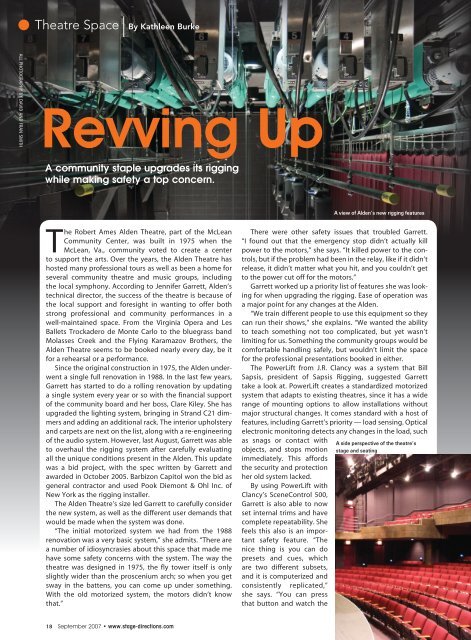Download a PDF - Stage Directions Magazine
Download a PDF - Stage Directions Magazine
Download a PDF - Stage Directions Magazine
You also want an ePaper? Increase the reach of your titles
YUMPU automatically turns print PDFs into web optimized ePapers that Google loves.
Theatre Space<br />
By Kathleen Burke<br />
ALL PHOTOGRAPHY BY DAVID AND FRAN SMITH<br />
Revving Up<br />
A community staple upgrades its rigging<br />
while making safety a top concern.<br />
A view of Alden’s new rigging features<br />
The Robert Ames Alden Theatre, part of the McLean<br />
Community Center, was built in 1975 when the<br />
McLean, Va., community voted to create a center<br />
to support the arts. Over the years, the Alden Theatre has<br />
hosted many professional tours as well as been a home for<br />
several community theatre and music groups, including<br />
the local symphony. According to Jennifer Garrett, Alden’s<br />
technical director, the success of the theatre is because of<br />
the local support and foresight in wanting to offer both<br />
strong professional and community performances in a<br />
well-maintained space. From the Virginia Opera and Les<br />
Ballets Trockadero de Monte Carlo to the bluegrass band<br />
Molasses Creek and the Flying Karamazov Brothers, the<br />
Alden Theatre seems to be booked nearly every day, be it<br />
for a rehearsal or a performance.<br />
Since the original construction in 1975, the Alden underwent<br />
a single full renovation in 1988. In the last few years,<br />
Garrett has started to do a rolling renovation by updating<br />
a single system every year or so with the financial support<br />
of the community board and her boss, Clare Kiley. She has<br />
upgraded the lighting system, bringing in Strand C21 dimmers<br />
and adding an additional rack. The interior upholstery<br />
and carpets are next on the list, along with a re-engineering<br />
of the audio system. However, last August, Garrett was able<br />
to overhaul the rigging system after carefully evaluating<br />
all the unique conditions present in the Alden. This update<br />
was a bid project, with the spec written by Garrett and<br />
awarded in October 2005. Barbizon Capitol won the bid as<br />
general contractor and used Pook Diemont & Ohl Inc. of<br />
New York as the rigging installer.<br />
The Alden Theatre’s size led Garrett to carefully consider<br />
the new system, as well as the different user demands that<br />
would be made when the system was done.<br />
“The initial motorized system we had from the 1988<br />
renovation was a very basic system,” she admits. “There are<br />
a number of idiosyncrasies about this space that made me<br />
have some safety concerns with the system. The way the<br />
theatre was designed in 1975, the fly tower itself is only<br />
slightly wider than the proscenium arch; so when you get<br />
sway in the battens, you can come up under something.<br />
With the old motorized system, the motors didn’t know<br />
that.”<br />
There were other safety issues that troubled Garrett.<br />
“I found out that the emergency stop didn’t actually kill<br />
power to the motors,” she says. “It killed power to the controls,<br />
but if the problem had been in the relay, like if it didn’t<br />
release, it didn’t matter what you hit, and you couldn’t get<br />
to the power cut off for the motors.”<br />
Garrett worked up a priority list of features she was looking<br />
for when upgrading the rigging. Ease of operation was<br />
a major point for any changes at the Alden.<br />
“We train different people to use this equipment so they<br />
can run their shows,” she explains. “We wanted the ability<br />
to teach something not too complicated, but yet wasn’t<br />
limiting for us. Something the community groups would be<br />
comfortable handling safely, but wouldn’t limit the space<br />
for the professional presentations booked in either.<br />
The PowerLift from J.R. Clancy was a system that Bill<br />
Sapsis, president of Sapsis Rigging, suggested Garrett<br />
take a look at. PowerLift creates a standardized motorized<br />
system that adapts to existing theatres, since it has a wide<br />
range of mounting options to allow installations without<br />
major structural changes. It comes standard with a host of<br />
features, including Garrett’s priority — load sensing. Optical<br />
electronic monitoring detects any changes in the load, such<br />
as snags or contact with<br />
objects, and stops motion<br />
immediately. This affords<br />
the security and protection<br />
her old system lacked.<br />
By using PowerLift with<br />
Clancy’s SceneControl 500,<br />
Garrett is also able to now<br />
set internal trims and have<br />
complete repeatability. She<br />
feels this also is an important<br />
safety feature. “The<br />
nice thing is you can do<br />
presets and cues, which<br />
are two different subsets,<br />
and it is computerized and<br />
consistently replicated,”<br />
she says. “You can press<br />
that button and watch the<br />
A side perspective of the theatre’s<br />
stage and seating<br />
18 September 2007 • www.stage-directions.com
















